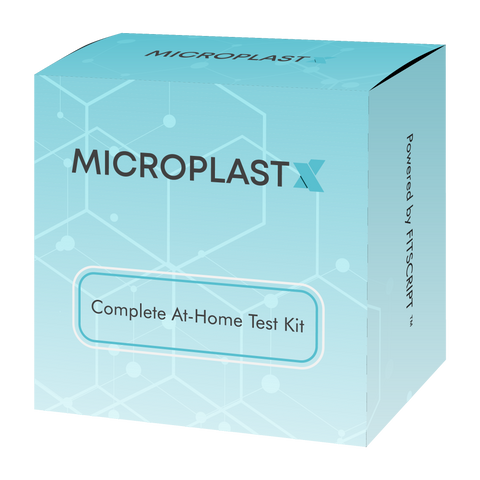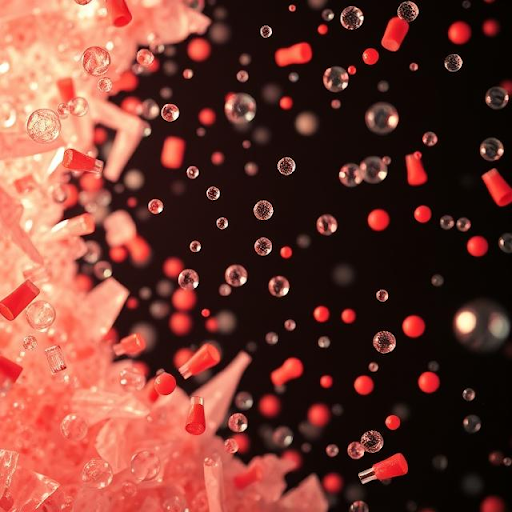What Are Microbeads? Understand Their Impact and How to Avoid Them
Many people are still asking: what are microbeads and why were they used in so many products? It's a really important question because understanding the microbeads definition helps us grasp a larger part of the microplastic problem. These tiny plastic spheres, usually smaller than five millimeters, were once a common ingredient in a surprising array of consumer goods.
The explanation of microbeads as an ingredient typically centered around their function. They were primarily used as exfoliants in facial scrubs, body washes, and toothpaste. Their tiny, spherical shape made them seem ideal for gently scrubbing away dead skin cells or polishing teeth. Cosmetic companies loved them because they were inexpensive, uniform in size, and felt smooth on the skin compared to natural exfoliants like crushed nuts or fruit pits, which could be irregular or sharp. This perceived gentle exfoliation led to their widespread adoption, and a comprehensive explanation of microbeads highlighted their texture and effectiveness.
Beyond cosmetics, they also found their way into some cleaning products for their abrasive qualities. However, what wasn't fully understood at the time was the severe environmental impact once these tiny plastics were washed down the drain. Their very design, to be small and persistent, made them a significant pollutant, leading to increasing concerns about their presence, and raising the question: what are microbeads doing to our planet? If you're concerned about your personal exposure to these or other microplastics, our MicroplastX Microplastics Blood Test Kit can provide clarity.
Which Products Still Contain Microbeads Despite Bans?
Even with growing awareness and some bans, people still wonder: which products still contain microbeads despite bans? While significant steps have been taken, the global picture of microbead regulation is complex. Understanding the microbeads definition is key here, as some manufacturers might try to use loopholes or different terms. The full explanation of microbeads includes knowing where they might still be lurking.
Many countries, including the US, UK, Canada, and Australia, have enacted bans on microbeads in rinse-off cosmetics and personal care products. This was a huge win for environmental protection. However, it's crucial to understand the limitations of these bans:
-
Rinse-off products only: Most bans specifically target products designed to be washed down the drain, like facial scrubs, body washes, and some toothpastes.
-
Leave-on products are often excluded: Products like makeup, sunscreens, and lotions, which are not immediately rinsed off, might still contain microbeads in some regions, depending on the specific legislation. The explanation of microbeads in this context highlights that their function might be as a bulking agent or for texture, rather than exfoliation.
-
Other plastic particles: Even if a product is microbead-free, it doesn't mean it's entirely plastic-free. Manufacturers might use other forms of microplastics that fall outside the narrow microbeads definition used in the bans.
-
Non-cosmetic products: Some bans don't cover household cleaning products or industrial abrasives, which might still contain microbeads.
So, while bans have reduced their presence in some common items, vigilance is still needed. Always check ingredient lists for plastic polymers to truly avoid them. When asking what are microbeads, remember the bans have limits. To truly understand your personal exposure and what might be in your system, consider learning how to test for microplastics.
How Do Microbeads Affect Human Health and the Environment?
The critical question, once you know what are microbeads, is: how do microbeads affect human health and the environment? The explanation of microbeads quickly moves from their functional use to their devastating consequences. Their tiny size, which made them effective exfoliants, also makes them a significant pollutant.
Environmentally, the impact is severe:
-
Ocean Pollution: Because they are so small and buoyant, microbeads easily pass through water treatment plants, which are not designed to filter such minuscule plastic particles. They then flow directly into rivers, lakes, and oceans. This contributes to the broader issue of microplastics in our oceans.
-
Ingestion by Wildlife: Marine animals, from plankton and fish to birds and whales, mistake microbeads for food. Once ingested, these plastics can cause internal injuries, block digestive tracts, and lead to starvation. They also act as carriers for harmful toxins, which can then be transferred to the animals' tissues.
-
Toxin Carriers: Microbeads act like sponges, absorbing persistent organic pollutants (POPs) and other harmful chemicals already present in the water. When ingested by marine life, these toxic chemicals can then transfer to the animals' tissues, moving up the food chain and eventually reaching us. This is a major part of the explanation of microbeads' environmental harm.
Regarding human health, the effects are still under active investigation, but the concerns are significant. If marine life consumes microbead-laden toxins, and we then consume that seafood, there's a potential for these plastic contaminants and associated chemicals to enter our bodies. When asking what are microbeads doing to us, we consider:
-
Chemical Leaching: The plastic itself, and the chemicals it absorbed, could potentially leach into our systems.
-
Physical Presence: The presence of tiny plastic particles in human tissues (as we've seen with broader microplastic research, including findings of microplastics in human organs) raises questions about inflammation and other cellular responses.
This highlights why understanding the microbeads definition and avoiding them is so crucial for both planetary and personal health. For those concerned about their own exposure, MicroplastX offers insight into your body's specific microplastic burden. Learn more and get your Microplastics Blood Test Kit today.
What’s the Difference Between Microbeads and Microplastics?
It’s a common point of confusion: what’s the difference between microbeads and microplastics? While they are related, understanding the distinct microbeads definition versus the broader term microplastics is key to grasping the full scope of plastic pollution. The explanation of microbeads helps clarify this distinction.
-
Microbeads Definition: Microbeads are a specific type of microplastic. They are intentionally manufactured, solid plastic particles, typically spherical, and usually under 5 millimeters in size. They were designed for a particular purpose, mainly as exfoliants in cosmetics, personal care products, and some cleaning agents. So, all microbeads are microplastics, but not all microplastics are microbeads.
-
Microplastics: This is a much broader, umbrella term. It refers to any piece of plastic less than 5 millimeters in size. Microplastics can originate from various sources:
-
Primary Microplastics: These are microplastics that were originally manufactured to be small, like microbeads, or plastic pellets (nurdles) used in industrial manufacturing.
-
Secondary Microplastics: These are far more prevalent. They are formed when larger pieces of plastic (like bottles, bags, fishing nets) break down over time due to exposure to UV radiation from sunlight, wind, waves, and other environmental factors. This includes microfibers shed from synthetic clothing during washing, or tire dust. You can find more information on the wide range of sources in articles discussing microplastic pollution.
So, while microbeads represent a targeted source of plastic pollution that has largely been addressed by bans, the vast majority of microplastics in our environment come from the breakdown of larger plastic items. The explanation of microbeads as a subset of microplastics is vital for a clear picture. The environmental and potential health concerns are similar across both, as they both lead to plastic contamination in ecosystems and potentially in the human body. To understand your own personal microplastic burden, consider learning how to test for microplastics.
How Can You Identify and Avoid Microbeads in Consumer Goods?
Knowing what are microbeads is one thing, but how can you identify and avoid microbeads in consumer goods? Even with bans in place, vigilance is still key to minimizing your exposure. The microbeads definition often means looking beyond simply packaging claims. A thorough explanation of microbeads will guide you on how to spot them.
Here's how to identify and avoid them:
-
Check the Ingredient List: This is your most powerful tool. Look for common plastic polymers that indicate microbeads. Key culprits include:
-
Polyethylene (PE)
-
Polypropylene (PP)
-
Polyethylene Terephthalate (PET)
-
Polymethyl Methacrylate (PMMA)
-
Nylon (PA)
-
Look for Plastic-Free or Microbead-Free Labels: Many brands now actively promote these claims. However, remember that microbead-free doesn't necessarily mean plastic-free (as discussed above, other microplastics might still be present).
-
Be Wary of Exfoliating or Scrubbing Products: If a product promises exfoliation but doesn't list natural ingredients like sugar, salt, coffee grounds, crushed nuts, or fruit seeds, it's worth double-checking the ingredient list for plastic. The explanation of microbeads as a scrubbing agent makes this a red flag.
-
Use Apps and Online Databases: Several apps and websites allow you to scan product barcodes or search ingredient lists to identify if they contain microbeads or other microplastics. These resources often provide a quick microbeads definition check.
-
Choose Reputable Brands: Opt for brands known for their commitment to sustainability and transparent ingredient sourcing.
By being an informed consumer, you can significantly reduce your contribution to microbead pollution and protect your own health. Understanding what are microbeads and knowing how to avoid them is a crucial step in reducing overall plastic exposure. For a personal insight into your body's plastic levels, consider our MicroplastX Microplastics Blood Test Kit.
Should You Get Tested If You’ve Used Products With Microbeads?
After learning what are microbeads and their widespread use, you might be wondering: should you get tested if you’ve used products with microbeads in the past? Given the extensive use of these tiny plastics before bans, it's highly probable that many people have been exposed. The full explanation of microbeads includes their journey into the environment and potentially our bodies. So, is plastic contamination testing a necessary step?
If you were a regular user of facial scrubs, body washes, or toothpastes containing microbeads, it's very likely that you've had some level of internal exposure. These particles readily entered waterways and, as we know, microplastics are now found in our food, water, and air. While your body has natural elimination pathways, smaller particles can be absorbed. Therefore, if you are concerned about your overall plastic burden, regardless of the source, getting tested can provide valuable personal insight.
A MicroplastX Microplastics Blood Test Kit can offer a clear picture of the microplastics currently circulating in your bloodstream. It doesn't tell you exactly when or from where the plastic came, but it does confirm their presence and concentration. This knowledge can be a powerful motivator to reinforce your efforts to reduce exposure and support your body's natural detoxification processes. While the microbeads definition points to a specific source, testing helps reveal the cumulative impact of all microplastic exposure, including those from environmental breakdown. For a deeper dive into the science of how these tests work, explore how to test for microplastics.




